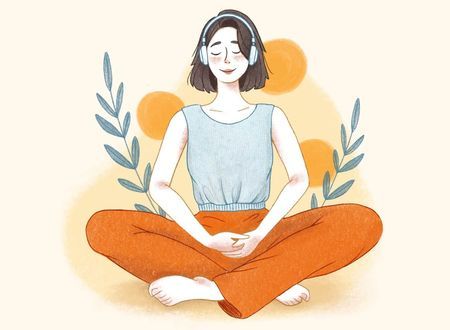The mountains are lush green, and here and there are blossoming trees of different colors, lavender, cream, and all. As if these giant silent wonders of nature are ageing gracefully. When peeking at these beautiful and patient mountains, and as I listen to the ever mellifluous river, sitting in front of a screen is not exactly the most attractive proposition. It’s a beautiful day. A little misty, a bit foggy, but at once bright and sunny. The kind where each breath is naturally an act of prayer, it’s the sort of quiet day where you don’t meditate because you are in meditation already. A wholesome day. And as I said, having to sit down and scribble a post is the last thing I would want to do. But, a man’s gotta do what a man’s gotta do.
Besides, on the path of mastery, what our mind wants must never interfere with what our mind must do. More or less, the theme of this writeup.
I was speaking to an intelligent and determined meditator the other day when he asked me what specific measures he could take to improve the duration and quality of his meditation. “As I build my practice from the current two hours to more,” he said, “I hope it won’t cause any damage to my spine as I do feel a bit sore in my lower back. And, how important is it to be perfectly still while I am meditating?”
There are as many ways of slipping into a meditative state as there are the number of species and psychedelics, perhaps. In its purest form, however, I can tell you that no matter what kind of meditation you do, two factors cannot be ignored if you wish to become adept in tapping into your superconscious state of mind. They are, one, the quality of your concentration and two, the stillness of your posture.
As you master concentration and stillness, the length and effectiveness of each session of meditation will improve exponentially. If right now you feel fidgety after thirty-six minutes, with the right routine and practice, you will sit still as a rock for even four hours and thirty-six minutes without so much as a flicker in your eyelid. What do I mean by the right practice, you ask?
That’s exactly why I am here today, punching away at the tired keyboard, or shall I say tickling the keys with enthusiasm… When I say “right practice”, what I mean is the things you can do on the path of self-discovery to go beyond the relaxing and calming effects of meditation to what it’s truly supposed to do for you. That is, set you free from all that binds you and pulls you back. When done right, meditation is liberation. To attain that purity and perfection, perfecting the posture (asana siddhi) is non-negotiable.
Imagine for a moment how you feel just before you are about to fall asleep. Your body demands a certain stillness, a sort of calm starts to engulf your thinking mind as if subduing its faculties. And just then, in that quiet and stillness, you slip into a different state of consciousness: sleep. In fact, yogic texts call sleep a “suspension of consciousness”. To experience the world of dreams or subconscious impressions in sleep, you ought to still your body and calm your mind. Meditation is no different in the sense that to experience a higher state of consciousness, the body and mind must come to a state of perfect stillness. You just have to sustain it for a short while (usually between 7 and 12 minutes) for body-consciousness to take a back seat.
In the absence of physical stillness, you are constantly reminded of your body during your meditation, preventing your mind from going beyond it. It’s like you sit down to have a nice sumptuous meal but you can’t get past the awkward shaped plate it’s being served in. The soup is too hot and it singes your tongue or the spoon is too big for your mouth or maybe there’s no fork and they have given you two toothpicks instead. You get the idea.
As you gradually increase the length of your meditation sessions, your body and mind begin to experience stillness for prolonged periods. Accomplishing this feat requires strength, stamina and discipline. The good news is that with a bit of change in your lifestyle, it’s entirely possible to make rapid progress. Without further ado, there are five things I strongly recommend any serious aspirant to pay special attention to. As follows:
Hydration
I can’t stress this enough but if you don’t keep your body hydrated, you will experience greater soreness in your muscles and not surprisingly, a more restless mind. Dehydration puts your solar channel in an overdrive mode which results in excessive thinking, faster aging and restlessness. You don’t want to over-hydrate yourself because the last thing you want is to interrupt your meditation by having to make frequent trips to the washroom. And, you certainly don’t want to be dehydrated either. Every individual’s body has different needs. Find your optimal balance and stay hydrated.
Nutrition
What you eat has a tremendous, immediate and lasting impact on the quality of your meditation. Experiment with different kinds of foods to see what sits well with your body. Eat in moderation, chew well, and go for a balanced diet. Do not deprive yourself of the right amount of protein and vitamins. Stay low on carbs. Excessive sugar reacts differently on different people. Some become lethargic and sleepy while others become energetic and fidgety. See what works for you. At any rate, just remember that there’s no hope of good meditation if your body is suffering from a lack of nutrition.
Yoga or stretching
One most definitive way to prolong your lifespan is by doing yoga. I say this without the slightest bias or exaggeration, that while there may be things better or worse than yoga, there’s nothing quite like yoga. It’s incredible how complete it is. Yoga is the gentle way of aligning your energies and chakras. Even a few minutes of yoga will improve blood circulation, arrest muscular atrophy, grant longevity, and give you better cardiac health. Any serious meditator has to devote some time every day to either doing yoga or stretching because it will have a direct bearing on the quality of your posture. I used to do forty-five minutes of yoga during my peak practice. Without it, there was no way that I could sit still for ten-hour stretches.
Sunlight
The right amount of sunlight, particularly the morning sun will not only give you vitamin D but will heal your tired muscles. We all have experienced the joy of the warm winter sun. It’s not without reason that the mind rejoices so much in that warmth. It knows your body needs it and sunlight has a direct correlation with our mental state. In fact, the Vedic lifestyle requires everyone to start their day by making an offering of gratitude (usually with water) by facing the morning sun. If you are planning to increase the duration of your meditation sessions, be sure to give your body 10-15 min of sunlight every day.
Breathing
Just before your meditation, calm your nerves and practice deep breathing for a few minutes. Usually 5-7 minutes are sufficient. You can do alternate breathing as well (known as anuloma-viloma pranayama. I’ve covered this in my book, A Million Thoughts or you can simply google it.) Practicing deep breathing is a simple but super effective method of harnessing the ten kinds of energies in your body.
That’s all there is to it, really. Factor in the five points above and be amazed at how swiftly you will make progress on the path. Your concentration, posture, and stamina will improve with each passing day. Keep walking and one day, before you know it, you will have championed the skill of effortless meditation. You will not have to meditate then, meditation will happen to you. You will become the object of your meditation. It’s evolution, a natural progression for the dedicated practitioner.
Ready…steady…stop!
Peace.
Swami
A GOOD STORY
There were four members in a household. Everybody, Somebody, Anybody and Nobody. A bill was overdue. Everybody thought Somebody would do it. Anybody could have done it but Nobody did it.
Don't leave empty-handed, consider contributing.It's a good thing to do today.









Comments & Discussion
240 COMMENTS
Please login to read members' comments and participate in the discussion.